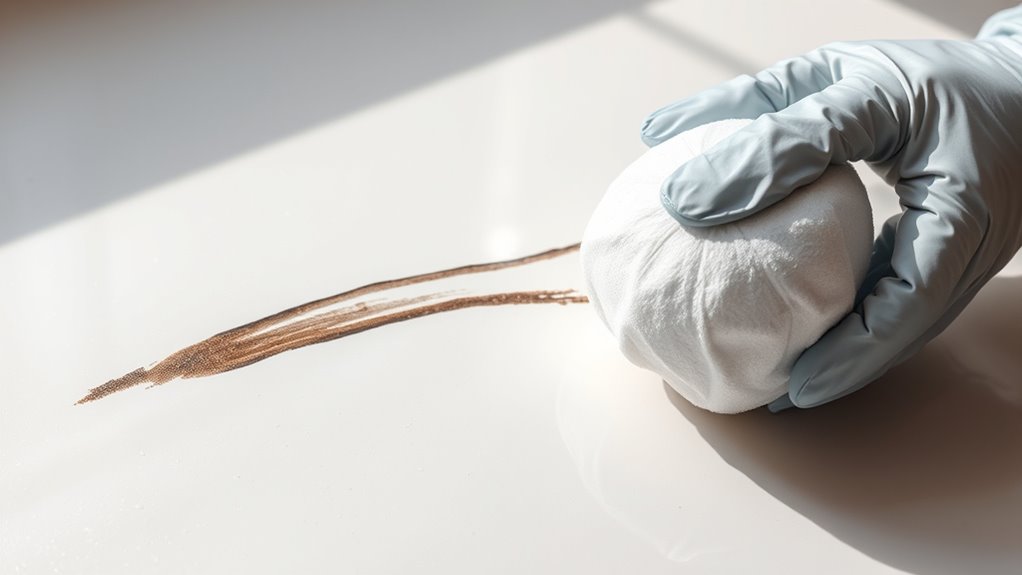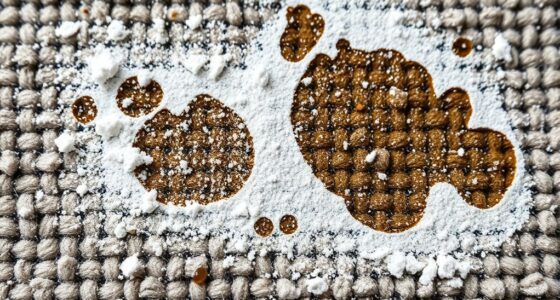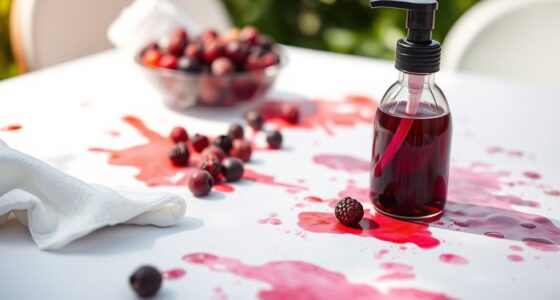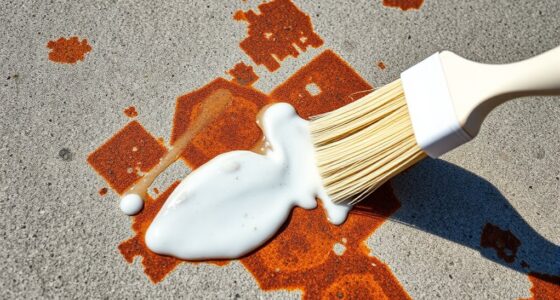To erase permanent marker from surfaces, you can use several methods tailored to specific materials. For plastic and vinyl, try rubbing alcohol or a dry-erase marker over the stain. For fabric, act quickly with rubbing alcohol or white vinegar. On wood, gently dab with rubbing alcohol or mix baking soda with toothpaste. Always test any method on an inconspicuous area first. Want to discover more effective solutions? There’s plenty more to explore!
Key Takeaways
- Use rubbing alcohol or nail polish remover on a cloth to gently dab the stain for effective removal.
- Overwrite the marker stain with a dry-erase marker, then wipe clean with a microfiber cloth.
- For fabric, apply alcohol-based products immediately, or use a mix of bleach and water for persistent stains.
- On wood surfaces, use a mixture of toothpaste and baking soda, applying along the grain for best results.
- Always test cleaning methods on inconspicuous areas first to avoid damaging the surface.
Understanding Permanent Marker Stains

When you encounter a permanent marker stain, understanding its composition can help you tackle the problem effectively.
Permanent markers primarily use pigments, which provide vibrant colors and durability, making them resistant to water and humidity. Unlike dyes, pigments don’t fade easily and are typically finer powders that enhance visibility.
Permanent markers rely on durable pigments for vibrant colors that resist fading, water, and humidity.
Solvents like isopropanol and ethanol allow the ink to flow but evaporate quickly, leaving behind the colorant and resin. The resins act as binding agents, ensuring that marks stay on surfaces and don’t wash away. Permanent markers can cause accidental stains on surfaces, further complicating the removal process.
Their non-polar nature contributes to the stain’s persistence, especially on non-porous surfaces. This combination of pigments, solvents, and resins is what makes permanent marker stains challenging to remove.
General Methods for Removal

Understanding the composition of permanent marker stains sets the stage for effective removal techniques. One popular method is the dry-erase marker technique; simply overwrite the stain and wipe it off with a microfiber cloth. For tougher stains, try solvent-based cleaners like rubbing alcohol or nail polish remover. Additionally, using baking soda can be effective for tougher stains when scrubbing in circular motions. Household options such as WD-40 or Mr. Clean Magic Eraser work well too. If you’re dealing with porous surfaces, mix equal parts vinegar and olive oil for gentle treatment. Just remember to avoid abrasive tools, as they can damage surfaces. Experiment with these methods to see which one suits your particular surface best, and don’t forget to test in an inconspicuous area first!
Techniques for Plastic and Vinyl Surfaces

Removing permanent marker stains from plastic and vinyl surfaces can be straightforward if you use the right techniques.
Start by applying rubbing alcohol or hydrogen peroxide with a microfiber cloth, gently rubbing the stained area. For a less chemical method, try using a dry-erase marker to break down the stain. Permanent marker stains can occur on various plastic items like containers, furniture, and decorative pieces.
If you prefer a physical approach, a Magic Eraser can effectively scrub away the marks. You can also create a paste with toothpaste and baking soda for gradual removal.
Always test your method on a small area first to avoid damage. After removing the stain, dry and buff the surface to restore its original look.
Persistence is key, so don’t give up if it takes a few tries!
Removing Permanent Marker From Fabric

Though it might seem intimidating, getting permanent marker out of fabric can be manageable with the right approach.
Start by treating the stain immediately; the sooner you act, the better your chances of removal. Use an alcohol-based product like rubbing alcohol or hand sanitizer to break up the ink. This is because ink in permanent markers penetrates cellulose, making it essential to act quickly.
If the stain persists, mix a bleach solution with water, but remember to test it on an inconspicuous area first. For delicate fabrics, opt for white vinegar.
Avoid putting the stained fabric in a hot dryer until the stain is completely gone, as heat can set the ink.
After treatment, launder the fabric according to its care instructions, and repeat the process if necessary for stubborn stains.
Effective Solutions for Wood and Furniture

When permanent marker stains land on wood or furniture, quick action can make all the difference in restoring the surface. Start by applying rubbing alcohol to a cloth and gently dabbing the stain. If that doesn’t work, try nail polish remover, but be cautious as it can affect finishes. You can also mix toothpaste with baking soda, applying it gently along the wood grain. Hairspray is another option; its alcohol content helps lift stains from painted surfaces. For a gentle approach, use a magic eraser or create a paste with baking soda and water. Different wood finishes may react differently to cleaning methods, so it’s essential to be mindful of the type of wood you are treating. Finally, always test these methods on an inconspicuous area first to verify you don’t damage your beautiful wood or furniture.
Cleaning Glass and Metal Surfaces

A few effective methods can help you tackle permanent marker stains on glass and metal surfaces.
For glass, try using nail polish remover, which contains acetone to break down the ink. You can also draw over the marker with a dry erase marker and wipe it away with a microfiber cloth. Rubbing alcohol works well too, leaving no residue behind. Rubbing alcohol is effective on various surfaces, including glass and metal.
Try nail polish remover or dry erase marker to easily remove permanent marker stains from glass surfaces.
For metal, dampen a cloth with rubbing alcohol or denatured alcohol to lift the stain. If you don’t have those, hairspray can be an alternative.
Always test a small area first to avoid damage, and remember to use gentle wiping motions to prevent scratching. Act quickly for the best results and repeat as needed for complete removal.
Utilizing Chemicals and Specialized Products

If you’re dealing with stubborn permanent marker stains, utilizing chemicals and specialized products can provide quick and effective solutions.
Start with rubbing alcohol or nail polish remover on non-porous surfaces like plastic, but be cautious as some materials might get damaged. Rubbing alcohol is effective for dissolving alcohol-based permanent markers.
WD-40 is great for walls; just remember to clean off the residue afterward.
For a unique approach, use a dry-erase marker to cover the stain before wiping it away.
A Magic Eraser works wonders on various surfaces, while a baking soda paste can gently tackle stains on wallpaper.
Hydrogen peroxide can also help on certain plastics.
With these options, you’re well-equipped to handle those pesky permanent marker marks!
Precautions for Delicate Surfaces

While tackling permanent marker stains, it’s important to exercise caution on delicate surfaces to prevent damage.
Exercise caution when removing permanent marker stains from delicate surfaces to avoid causing damage.
For hard non-porous surfaces, you have a lower risk of ink penetration, but with soft porous surfaces like fabric or leather, you need to be gentle. Always test any cleaning solution on an inconspicuous area first, especially with alcohol-based cleaners and acetone, which can harm finishes. Success depends on surface type when selecting the appropriate cleaning method to ensure effective removal.
Use non-abrasive materials like microfiber cloths to avoid scratches. When dealing with wood, remember that excessive rubbing can damage the finish.
For painted walls, test to verify you don’t lift paint or wallpaper. By taking these precautions, you’ll preserve the integrity of your delicate surfaces while effectively removing permanent marker stains.
Tips for Preventing Permanent Marker Stains

To keep permanent marker stains at bay, it’s essential to take proactive steps before you even pick up a marker.
Start by ensuring your surfaces are clean and dry, as this helps the ink adhere better. Choose markers suitable for the specific material; for example, use glass markers on glass surfaces. Additionally, be sure to prepare the surface by scrubbing and cleaning thoroughly to eliminate any residues.
After marking, consider applying a clear sealant like nail polish to protect the ink. For fabric, pre-treat with a stain-resistant spray.
Avoid exposing marked areas to direct sunlight or harsh chemicals, which can damage the ink. Regularly clean surfaces to prevent dirt buildup and fading.
Finally, educate users on proper handling techniques to minimize accidental stains and smudges.
Frequently Asked Questions
Can Permanent Marker Stains Be Completely Removed From All Surfaces?
Permanent marker stains can be tricky to remove completely from all surfaces.
While some materials respond well to cleaning methods, others may not give you the results you hope for. Surfaces like plastic, glass, and fabric often yield better results, while wood and leather can pose challenges.
You’ll need to act quickly and choose the right cleaning product, but even then, success isn’t guaranteed on every surface.
Always test in an inconspicuous area first!
What Should I Do if a Stain Persists After Trying Removal Methods?
If you’ve tried everything and the stain’s still hanging around, don’t throw in the towel just yet!
Consider using a specialized stain remover or consult a professional cleaner for a fresh perspective. Sometimes, a second opinion can work wonders.
If all else fails, think about replacing the affected surface, especially if it’s valuable.
Don’t let a stubborn stain get the best of you; there’s always a solution waiting to be discovered!
Are There Any Natural Alternatives for Removing Permanent Marker?
If you’re looking for natural alternatives to remove permanent marker, you’ve got several options.
Olive oil and coconut oil can gently lift stains from surfaces, while lemon oil helps dissolve ink.
A mixture of vinegar and water works wonders on wood.
You can also try using baking soda as a paste or salt scrub for tougher stains.
These eco-friendly solutions are effective and safe for many surfaces, so give them a shot!
Will Permanent Marker Stains Come Back After Removal?
Imagine a once pristine surface now marred by a stubborn ink stain, haunting you like a ghost.
After you’ve worked hard to remove it, will it rise again? It can, especially if the ink’s deeply embedded or the cleaning method wasn’t thorough.
Factors like the surface type, age of the stain, and environmental conditions play a role.
Always act quickly and choose the right products to minimize the chances of it returning.
How Can I Prevent Permanent Marker Stains From Setting in the First Place?
To prevent permanent marker stains from setting, start by cleaning surfaces with soap and water or alcohol to remove grease and debris.
Use high-quality, fade-resistant markers for better results.
If you’re working on high-risk surfaces, consider applying a protective layer like clear nail polish or modge podge.
Regularly check and maintain these surfaces, and always handle them with clean, dry hands to avoid accidental smudges.
Conclusion
In summary, erasing permanent marker stains isn’t just a chore; it’s a battle against the stubbornness of ink that feels like a war! With the right techniques and solutions, you can reclaim your surfaces and restore them to their former glory. Remember to choose your methods carefully, especially on delicate materials, and don’t forget to prevent future mishaps. Armed with these tips, you’ll feel like a cleaning superhero ready to tackle any ink-related challenge!









